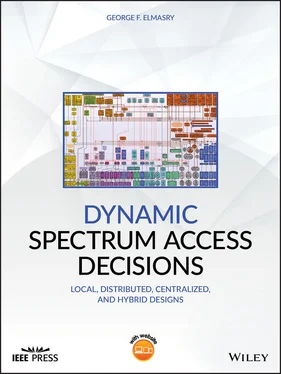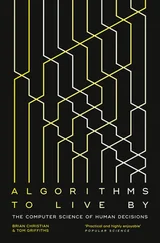5.3.3.5 Co‐site Interference Impact
Metric name : Co‐site impact.
Metric description : The ability to reduce co‐site impact on the assigned spectrum.
Metric measured property : SNIR.
Metric scale : dB.
Metric source : The DSA cognitive engines can track the SNIR from the collected spectrum sensing information and create an average for each waveform according to the waveform signal characteristics.
Note : Co‐site impact may or may not be tolerable by a given waveform. This metric can show the average time SNIR exceeded a given threshold that is considered intolerable while co‐site interference was known to exist and was accepted because of a policy or because of the limited availability of alternative spectrum bands that can be used. 8
The above metrics are just examples of what can be considered in DSA cloud services meteorology. The design can create categories of metrics. For example, the design can consider QoS category metrics to include packet delay, loss, and jitter. The design can consider security category metrics to include exposing a node to an eavesdropper or exposing a network to a jammer, the metric could measure the time of exposure to these security risks. The design can also consider the need for human intervention. A network administrator monitoring the use of DSA resources may intervene in cases of complete failure of the system to recover autonomously. The number of incidents that require human intervention can be turned into a metric. Some IaaS references name this metric the automatization degree.
5.3.3.7 Generalizing a Metric Description
One of the challenges that can face the designer of DSA as a set of cloud services for heterogeneous networks is ensuring consistency. We discussed in the previous chapters how different waveforms can have different link status metrics and how a common definition for link health metrics between all the waveforms used in a heterogeneous system is needed such that services as reactive routing are optimized appropriately. The design of DSA as a set of cloud services needs to also ensure that a metric is measured consistently with regard to all types of waveforms and all points where the metric is measured. Co‐site interference impact as a DSA service metric is a good example of creating consistency. Different signals have different tolerance to co‐site interference. Co‐site interference can have different levels of spectral density in different frequency harmonics. The co‐site impact as a DSA service metrics has to be normalized between all waveforms such that the metric evaluation is consistent and means the same for all waveforms.
DSA can be designed to be a set of cloud services that are IaaS type. The design of DSA as a set of cloud services have some commonality with standard IaaS services and have some unique aspects that must be considered. This chapter offered a generic model in how to design DSA as a set of cloud services and some design concepts that can be followed. This chapter also covered some aspects of the metrology of DSA as a set of cloud services. As the reader goes through the next chapter, it will be seen how 5G cellular dynamic spectrum management is a special case of the generic model presented in this chapter. In 5G opportunistic and nonopportunistic spectrum bands are managed dynamically and spectrum resources are offered to users as services based on a service agreement between the user and the 5G service provider.
1 Following the examples of DSA cognitive engine threads in Section 5.2, draft some DSA cognitive engine threads that can be added to the threads explained in Section 5.2.
2 Following the examples of DSA cloud metrics in Section 5.3, draft the details of the DSA metric of control traffic volume divided into two sub‐metrics, one for upward control traffic and one for downward.
1 CSCC, Practical Guide to Service Level Agreements Version 1.0, April 2015. Available at: https://www.omg.org/cloud/deliverables/CSCC-Practical-Guide-to-Cloud-Service-Agreements.pdf.
2 Cloud Computing Service Metric Description, US Department of Commerce, Publication 500‐307, NIST, April 2018.
3 Evaluation of Cloud Computing Services Based on NIST SP 800‐145, US Department of Commerce, Publication 500‐322, NIST, February 2018.
4 ISO/IEC 20926:2009, Software and systems engineering – Software measurement. IFPUG functional size measurement method, 2009.
5 Kushagra, K. and Dhingra, S., Modeling the Ranking of Evaluation Criteria for Cloud Services. International Journal of Electronic Government Research, vol. 14, pp. 64, 2018.
6 Polash, F., Abuhussein, A., and Shive, S., A survey of cloud computing taxonomies: Rationale and overview. 9th International Conference for Internet Technology and Secured Transactions 2014, pp. 459–465, 2014.
7 Ramachandran, M. and Mahmood, Z., Requirements Engineering for Service and Cloud Computing. Springer, 2017. ISBN 978‐3‐319‐51309‐6.
8 Siegel, J. and Perdue, J., Cloud Services Measures for Global Use: The Service Measurement Index (SMI). Service Research & Innovation Institute (SRII) Global Conference, IEEE, San Jose, CA, July 24–27, 2012.
9 The NIST Definition of Cloud Computing, US Department of Commerce, Special Publication 800‐145, NIST, September 2011.
1 1 An entity is a network node, a gateway or the central arbitrator, as explained later in this chapter.
2 2 Most of the spectrum access systems (SASs) developed for the citizens broadband radio service (CBRS) in the USA, which operate around the 3.5 GHz band, offer DSA as a set of cloud services. CBRS allows enterprises to build their own LTE networks and share the band with the LTE cellular infrastructure.
3 3 Interference detection can be an outcome of decision fusion. As explained earlier, hypothesizing interference by a sensor at any time instant does not necessarily lead to interference detection. Fusion of many hypotheses that may come from different sensing sources is what produces a decision that interference is above a certain threshold, which requires new frequency assignment.
4 4 In military communications, all lower echelon networks are wireless MANETs. These wireless networks can be lower tier waveforms with small spectrum footprint and upper tier networks with large spectrum footprint.
5 5The correct term to use here is frequency band not frequency. A frequency band is defined by a central frequency and bandwidth. The term frequency is used throughout this book loosely to mean a frequency band a network is operated with in order to differentiate an operational frequency band used by a network from the known defined frequency bands such as the HF band, the VHF band, and the UHF band.
6 6 Many decision fusion techniques use heuristic algorithms because reaching an optimum solution for a large number of networks and a large number of nodes within each network can be too computationally extensive to produce timely DSA services. Reducing the order of computational complexity is beyond the scope of this book.
7 7 Notice that considering control traffic volume impact is not simple or straightforward. A DSA design approach can add more control traffic but in the meantime makes the use of spectrum resources much more efficient. Such design is better than lowering the control traffic volume at the expense of reducing the efficiency of spectrum resources use. Although one can use a metric to measure control traffic, this metric's impact comes secondary to the metrics that measure throughput efficiency.
Читать дальше












